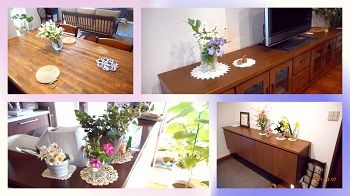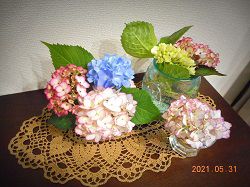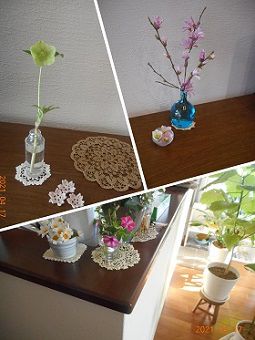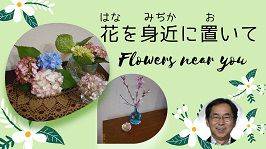Blogs edited and submitted by Chiho Kamioka
JOI Support staff and manager.
Flowers near you
- Font size: Larger Smaller
- Hits: 1201
- 0 Comments
- Subscribe to this entry
Ikebana Japanese flower arrangement
Ikebana is a Japanese form of flower arranging that was started in the 15th Century by a monk named Senkei Ikenobo. It is a highly stylized form of art and can take years to master.
It is one of the most celebrated art forms in Japan. It can express the changes of seasons and also the changes that can be seen as flowers age.
In this blog for Japanese learners by Japanese language teacher Hiroshi Yamamoto, you can read his slice of life story about living with this sense of flowers in your house, as well as study Japanese by listening to Yamamoto sensei read the blog himself.
Learn new Kanji and practice your reading skills too.
花を身近に置いて
Flowers near you

By YAMAMOTO Hiroshi

今、あなたの部屋の中に花はありますか。私の家にはリビングなどに何時も花があり、季節の変化を部屋の中でも楽しめます。
花はほとんど家の庭で育てているか、または近くの家の庭からもらったものです。家内は若い頃、生け花を習っていました。もう習うことはしていませんが、家では生け花を続けています。

花は庭の中ではたくさんの植物の中にありますので、あまり目立ちません。しかし、部屋の中で生花にすると、とても素敵に見えます。それは、一番きれいな時期に採って来て、それぞれの花の良さを引き出すように活けているからだと思います。
しかし生け花は、必ず少しずつ花が傷んで、全体の形が崩れます。すると、家内は傷んだ花を間引きます。そして、残された花の良さを引き出すように、最後まで全体の形を整えながら活け続けます。それはまるで、年を取っても素敵な人生を送っている人のようです。
花を身近に置いて見て、どのような物にも良い点があり、それを活かすことの素晴らしさを感じました。 皆さんも、身近な所に花を置いて、その変化を楽しんでみてはどうでしょうか。

To listen to this blog, please watch our Youtube video.
花(はな)を身近(みじか)に置(お)いて
今(いま)、あなたの部屋(へや)の中(なか)に花(はな)はありますか。私(わたし)の家(いえ)にはリビングなどに何時(いつ)も花(はな)があり、季節(きせつ)の変化(へんか)を部屋(はや)の中(なか)でも楽(たの)しめます。
花(はな)はほとんど家(いえ)の庭(にわ)で育(そだ)てているか、または近(ちか)くの家(いえ)の庭(にわ)からもらったものです。家内(かない)は若(わか)い頃(ころ)、生(い)け花(ばな)を習(なら)っていました。もう習(なら)うことはしていませんが、家(いえ)では生(い)け花(ばな)を続(つづ)けています。
花(はな)は庭(にわ)の中(なか)ではたくさんの植物(しょくぶつ)の中(なか)にありますので、あまり目立(めだ))ちません。しかし、部屋(へや)の中(なか)で生花(いけばな)にすると、とても素敵(すてき)に見(み)えます。それは、一番(いちばん)きれいな時期(じき)に採(と)って来(き)て、それぞれの花(はな)の良(よ)さを引(ひ)き出(だ)すように活(い)けているからだと思(おも)います。
しかし生(い)け花(ばな)は、必(かなら)ず少(すこ)しずつ花(はな)が傷(いた)んで、全体(ぜんたい)の形(かたち)が崩(くず)れます。すると、家内(かない)は傷(いた)んだ花(はな)を間引(まび)きます。そして、残(のこ)された花(はな)の良(よ)さを引(ひ)き出(だ)すように、最後(さいご)まで全体(ぜんたい)の形(かたち)を整(ととの)えながら活(い)け続(つづ)けます。それはまるで、年をとっても素敵(すてき)な人生(じんぜい)を送(おく)っている人(ひと)のようです。
花(はな)を身近(みじか)に置(お)いて見(み)て、どのような物(もの)にも良(よ)い点(てん)があり、それを活(い)かすことの素晴(すば)らしさを感(かん)じました。 皆(みな)さんも、身近(みじか)な所(ところ)に花‘はな)を置(お)いて、その変化(へんか)を楽(たの)しんでみてはどうでしょうか。
Flowers near you
Do you have any flowers in your rooms at the moment? There are always flowers in my house's living room, so we can enjoy the change of seasons indoors as well.
The flowers are mainly grown in our garden, and there are some that we receive from our neighbour's garden. My wife used to learn Ikebana Japanese flower arrangements. She doesn't learn it anymore, but she continues to do Ikebana at home. We have a lot of flowers in the garden in flower pots but they do not stand out. But when you use them in flower arrangements in a room, they look really wonderful. And I think this is because she picks them at their most beautiful stage of growth, and arranges them in a way that brings out their qualities.
However, in the arrangements, the flowers deteriorate little by little and the entire form starts to lose shape. When this happens, my wife thins out the damaged flowers. Then this brings out the qualities of the leftover flowers and you can continue to display them until the end by continuing to touch up their general form. And this looks exactly like living a good life even as you age.
By looking at flowers that are close to me, I can see the good points of each one, and I get to feel what a wonderful thing it is to bring these out. Why don't you try to put some flowers near you and enjoy their changes as well?
家内(かない):wife
生(い)け花(ばな):ikebana; Japanese art of flower arrangement
習(なら)う:to take lessons in
目立(めだ)つ:to be conspicuous
素敵(すてき):lovely; nice;
採(と)る:to pick
引(ひ)き出(だ)す:to bring out
活(い)ける:to arrange
傷(いた)む:to be damaged
崩(くず)れる:to get out of shape
間引(まび)く:to thin out
整(ととの)える:to arrange
素晴(すば)らしい:wonderful

Konnichiwa! My name is Hiroshi Yamamoto. I live in Oita in Kyushu with my family (my wife, daughter and an old female cat). Oita is famous for hot springs. I often visit hot springs in the winter.
My hobbies are gardening and watching soccer. When caring for my plants, I notice their daily changes and I feel relaxed. About soccer, I played soccer until about 20 years ago. But now I just watch the game.
I worked for a machine manufacturer for about 40 years. During that time, I worked in various departments including factory, trade, research and development, sales, general affairs, accounting, and auditing. I think I can help you to understand about business, industry and life in Japan from my experience.
What is your purpose of studying Japanese? Let’s make your dream come true by learning Japanese. I will do my best in our class to help you achieve your goals. Please knock on the classroom door at any time.


